One Nation, Under Dog: An ode to the hot dog
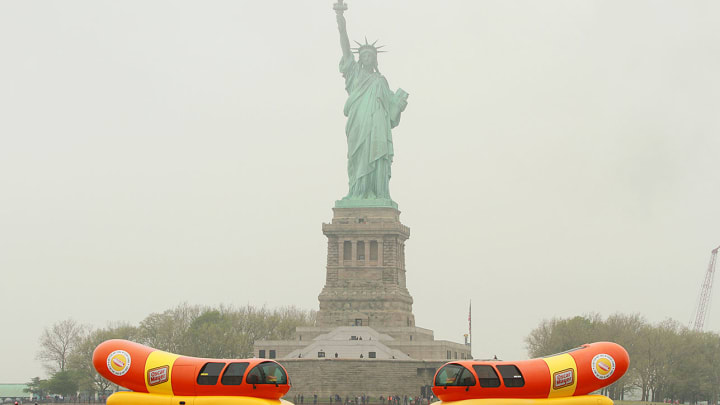
There's only one Colossus in the Coliseum. As he watches his beloved Athletics, Oakland fans in turn watch Joey Chestnut and try to place his face. Did we go to school together? one wonders. But then our hero hails a hot dog vendor, and in doing so he signals—like Mozart cracking his knuckles, or Einstein stroking his chin—an imminent act of genius.
Chestnut is the nine-time winner of the Nathan's Hot Dog Eating Contest, that annual Independence Day bacchanal; he's a man handsomely compensated for consuming dogs, as he did 73 1/2 times in 10 minutes at a Nathan's qualifier last June. But eating hot dogs at a ballgame is no busman's holiday, because ingesting cased meats is both Chestnut's vocation and his avocation. "It's pretty rare for me," says the 33-year-old native of Vallejo, Calif., "to be someplace that serves hot dogs and not eat one."
When Chestnut feeds a dog into his maw, like a log into a wood chipper, A's fans respectfully lower their own frankfurters and manually close their gaping mouths. With a bunned meat-zeppelin in hand, he instantly transforms from obscure to renowned. "It triggers the memory of the Fourth of July," says Chestnut, who considers every one of the nacho-eating spectators in the ballpark—with their candy-flossed fingers and their frosty-malted mustaches—a healthy eater. "Everything at a baseball game is pretty much health food if you subscribe to the theory that you're eating what makes you happy," he says. "As long as you don't eat like that every day, dude."
Last season alone, 19.4 million dogs were eaten in major league parks (and not all of them by Chestnut) according to the National Hot Dog and Sausage Council, a meat lobby that has, one hopes, an actual meat lobby on the ground floor of its headquarters in Washington, D.C. Of course the NHDSC is in our nation's capital, for the hot dog is an edible e pluribus unum ("out of many, one"), a comestible made of cast-off parts, the whole greater than its constituent components, like the American ideal from which it sprang.
"So the hot dog doesn't just contain connective tissue. It is connective tissue, binding us to one another, at ballparks in particular."
The hot dog has been emblematic of our hopes and dreams since the 19th century. "It was absolutely part of a deliberate program by nationalists and reformers to integrate the new immigrant population," says the cultural historian Bruce Kraig, author of Man Bites Dog: Hot Dog Culture in America and a man who has lectured on the subject at Oxford and the Library of Congress. "Part of that integration involves baseball games. By 1900, the working class guy can go on a Sunday—his only day off—to the cheap seats, the 10-cent seats, and the guy next to him is speaking Italian, and maybe he himself is from Ireland, and they're all eating hot dogs. You get cheap meat—usually a nickel—that you can eat standing up, chanting 'Go Giants!' or 'Go Sox!' We're all New Yorkers now ... or Chicagoans or Cincinnatians. We're all Americans. So hot dogs serve a critical function. People eating together, as anthropologists will tell you all the time, is an integrative thing. It keeps the community and the body politic together."
So the hot dog doesn't just contain connective tissue. It is connective tissue, binding us to one another, at ballparks in particular, where their consumption has become almost compulsory. "Baseball and hot dogs just go together," says Tom Lohr, a 55-year-old retired Navy veteran who has traveled to every MLB ballpark and countless minor league parks explicitly to eat and rate their dogs. "Why does a glass of wine taste better when you're sitting around a campfire with friends? It's the same wine that was previously sitting in your kitchen. The difference is the ambience. It's almost a crime to go to a baseball game and not have a hot dog." (Lohr would like to punish even some who do eat them. "I think people over 12 who put ketchup on hot dogs should have to do 100 hours of community service," he says. "It's the desecration of a national food. It's like defacing Mount Rushmore.")
In truth, the hot dog is the American id, our good and our bad, both humble street meat (the workingman's meal) and humility's opposite. ("There's not enough mustard in the world to cover that hot dog," A's pitcher Darold Knowles once said of splashy teammate Reggie Jackson.) It is emblematic of patriotism and gluttony, of backyard barbecues and corporate flimflammery. ("What do they put in this thing?") Like love itself, you do not want to see it being made, though when confronted with the spectacle, you probably could not look away.
Your guide to the best—and weirdest—ballpark food from all 30 MLB stadiums
As the man who turned the off-putting act of the Nathan's Hot Dog Eating Contest into a television ratings magnet, George Shea, cofounder of Major League Eating, has done more than any other to put the hot dog at the center of a competition in its own right. When he annually emcees the event, broadcast live on ESPN, Shea wears a straw boater that is fraught with meaning for our troubled times.
The hat evokes The Music Man. The hat wants to sell you a monorail. "That hat is a little bit sports announcer, a little bit apocalyptic preacher, a little bit Coney Island barker," says Shea. The hat is an homage to legendary New York p.r. man Max Rosey, who popularized the Nathan's contest in the 1970s and wore a Styrofoam version, the sort that begged you to take a bite out of its brim or punch a hole in its crown. Shea's is the real thing, costing $200. "You can imagine, when I carry it onto a plane in a bag, the other passengers are thinking"—here Shea sighs heavily in imitation—"Omigod, I'm sitting next to a guy in a barbershop quartet."
The hat is all of these things: sports announcer, televangelist, carnival barker, crooner on the village square. But then, so is America. One nation, under dog, indivisible ...
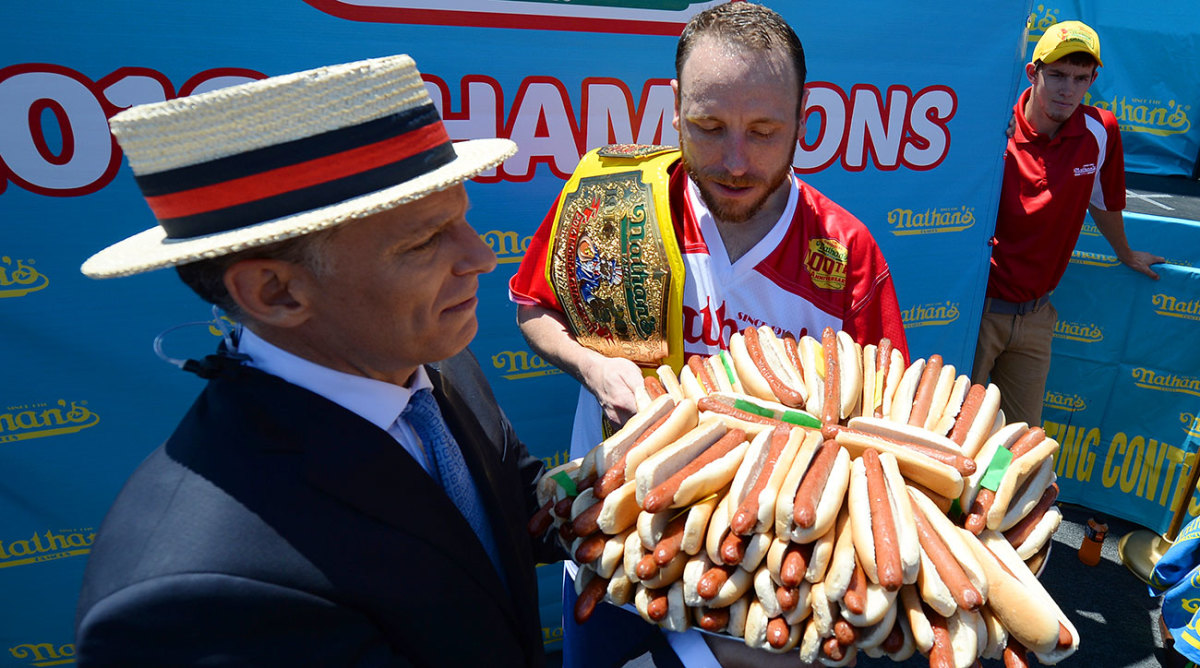
Shea's straw boater also tells people that the Nathan's contest isn't entirely self-serious, which is why the emcee describes its combatants as "horsemen of the esophagus" and why he often says of the great Chestnut, "He has God's user name and password." Perhaps more than any other man in human history, Shea seeks to imbue the tube steak with the operatic gravitas it deserves. "They say competitive eating is the battleground on which God and Lucifer wage war for men's souls," he once declared at Nathan's. To which he adds now, with a note of humility and a nod to the divine, "I don't know where I got that line."
"I heard this phrase," Shea says, and here he affects an ominous baritone: "The black death, a pandemic so devastating ... And that purple language has always resonated with me. The power of outrageous language to drive emotion, as in movie trailers—In a world ... in a time—that kind of language creates emotion, even when the audience knows you're joking."
The hot dog is otherwise entirely without pretense. It is, as Kraig notes, the first fast food in our Fast Food Nation, self-contained, designed to be eaten on the go. "When Joey is in Buffalo on Labor Day eating chicken wings, he's the hero, the star, and everyone wants a selfie," Shea says. "But in this one instance, on the Fourth of July, Coney Island, the hot dog—all of it becomes a metaphor for summer. People don't even know what Coney Island is. But when Joey holds that championship belt, the contest stands for something much more than the sum of its parts." That's precisely what the hot dog is, and America too: squeezed into a casing, forever in peril of rupture, somehow holding together.

Hot dogs have fed the nation's darkest themes and its greatest athletes. Wayne Gretzky is Canadian, but he ate hot dogs before games as a matter of routine, and then he moved to Los Angeles, whose citizens eat more hot dogs than any other municipality's in the nation. (Dodgers fans, likewise, eat the most dogs in the big leagues.) Michael Jordan, when he took the mantle of America's Greatest Athlete, was practically required to bite into a hot dog in a Ball Park Franks commercial. (And so he dutifully did.) Tiger Woods had a hot dog thrown at him by a man running onto the 7th green at CordeValle during the final round of the Frys.com Open in 2011. ("I looked up and the hot dog was in the air," Woods said, with a when-pigs-fly sense of wonder.) Red Auerbach liked a dog and a Coke for breakfast. After his final play in the NFL—knocked out cold in Minneapolis in '10—Brett Favre retreated to his locker room for a culinary coda to his career: the improbable pairing of a hot dog and a hot cocoa, a shot of summer with a winter chaser.
The hot dog is central, in fact, to the stories of two of our more celebrated athletes. When Cassius Clay returned to Louisville from the 1960 Olympics in Rome with his gold medal, he went straight to a downtown lunch counter and asked for a Coke and a hot dog—America on a place mat. "We don't serve Negroes," the waitress said, to which Clay replied, "I don't eat them." He would later say that it was in this moment, denied a hot dog and his humanity, that he resolved to convert to Islam—its proscription of pork notwithstanding—and become Muhammad Ali.
As a child at St. Mary's Industrial School for Boys in Baltimore, George Herman Ruth and his pals were rewarded with three "weenies" for Sunday morning breakfast. Those three weenies stoked a legend of a bottomless (if often mythical) appetite for dogs. Later, Ruth's pregame routine—like young Gretzky's—was a couple of hot dogs, washed down with bicarbonate soda. According to the Babe's biographer, Robert Creamer, a newspaper writer named W.O. McGeehan invented the story that Ruth collapsed after eating a dozen dogs right before surgery for an abdominal abscess. (Ruth's only real rival as an American icon of excess, Elvis Presley, had hot dogs soaked in sauerkraut smuggled into his own hospital room.)
Another legend has Ruth eating anywhere from 12 to 24 hot dogs between games of a twin bill, a feat Chestnut replicated in a trice at Yankee Stadium. "Joey is a legitimate American hero," says Shea. "You can ask yourself How? You can ask yourself Why? But when he walks down the street, people are excited to see him." This is the true sausage link from Ruth to Presley to Ali to Chestnut: the happiness they've carried to others like a contagion.
Happy 4th! Classic SI covers ... with hot dogs
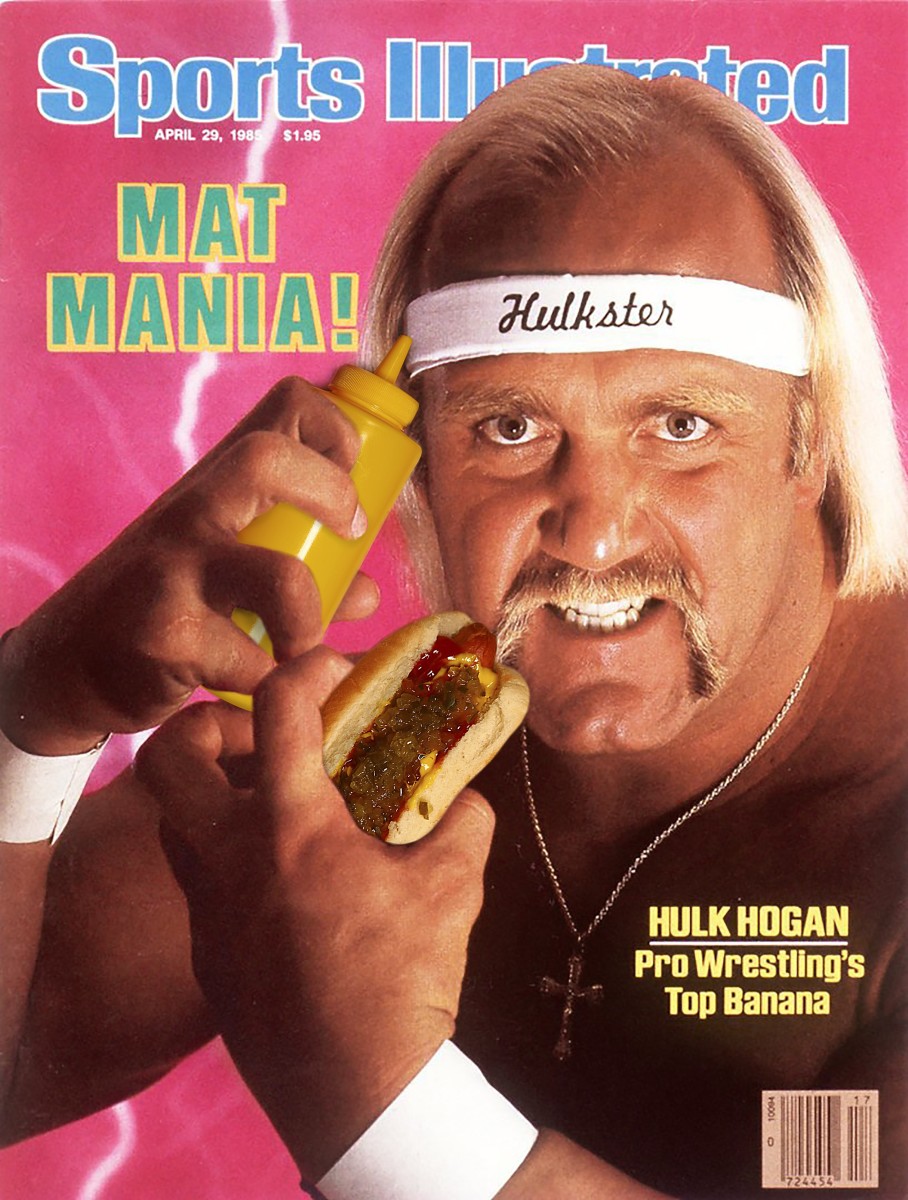
Hulk Hogan: Pro wrestling's top (hot dog*). Originally from April, 1985.
Brandi Chastain
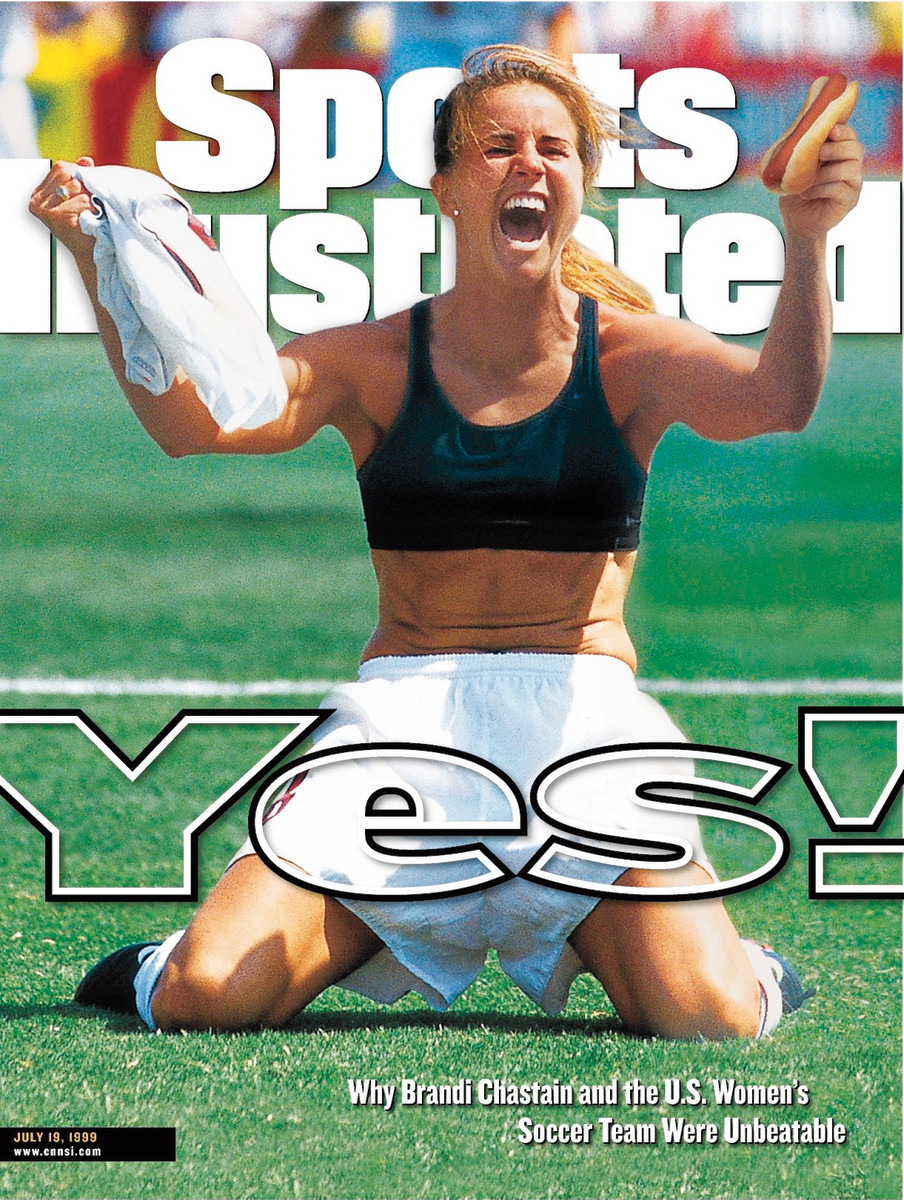
Originally from July, 1999.
Muhammad Ali, Don King, Joe Frazier, Hot Dogs.
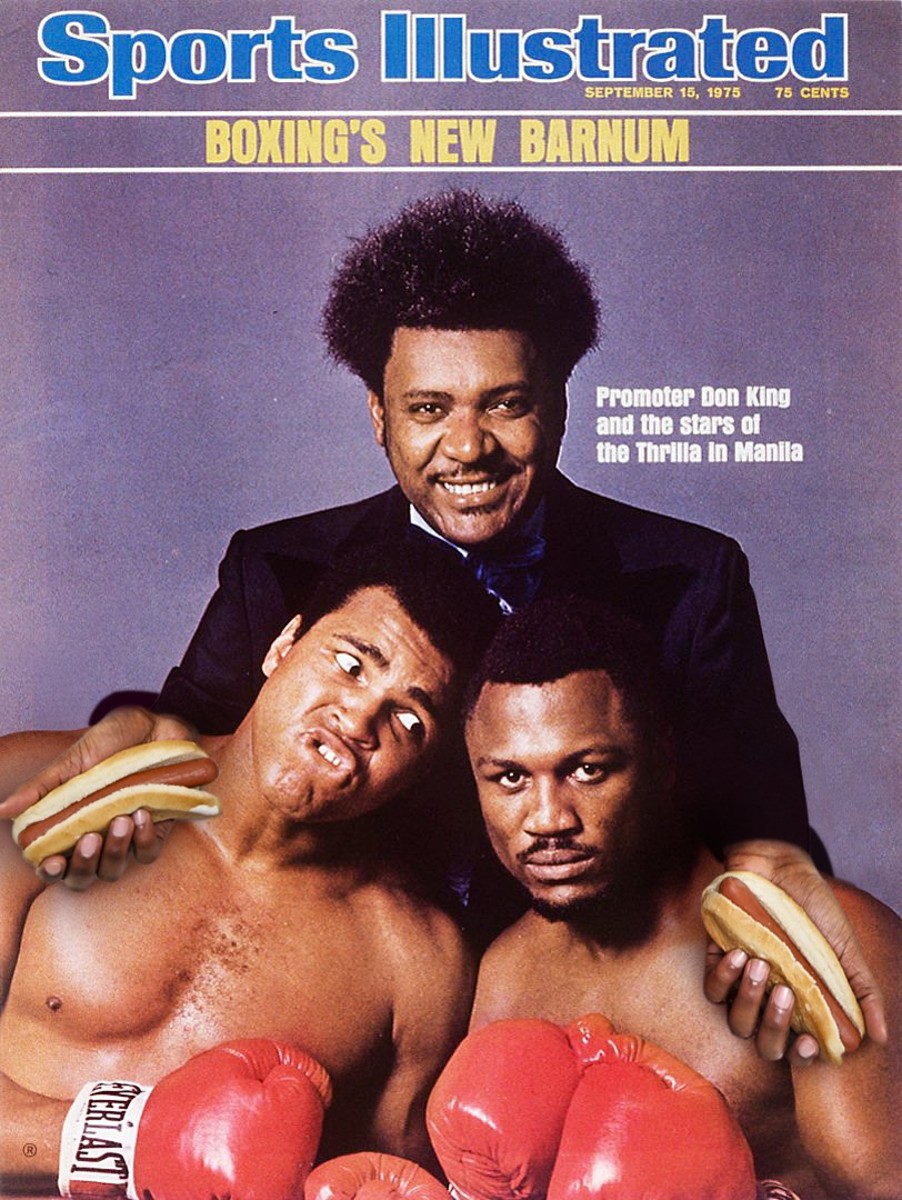
Originally from September 15, 1975.
Phil Jackson
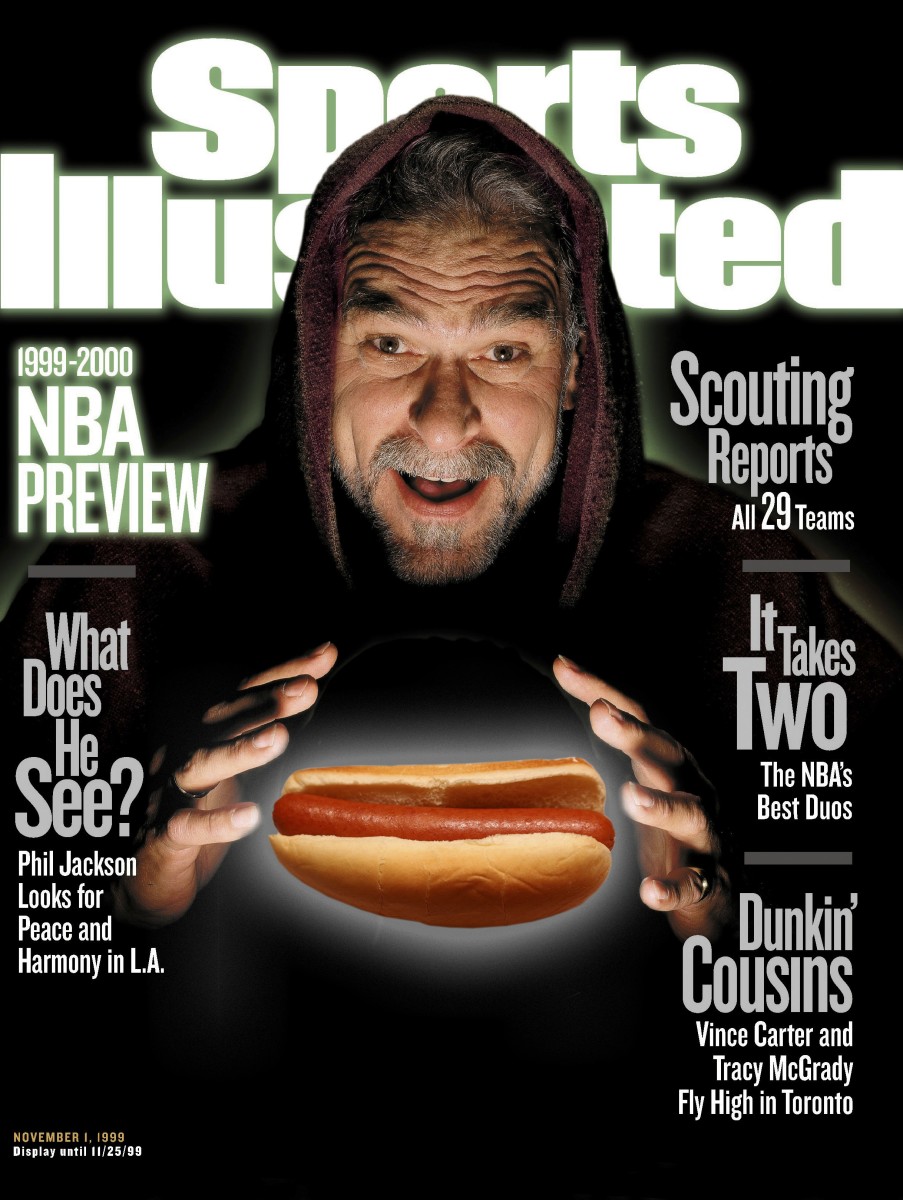
Back in happier days for Phil Jackson. Originally from November, 1999.
Troy Polamalu
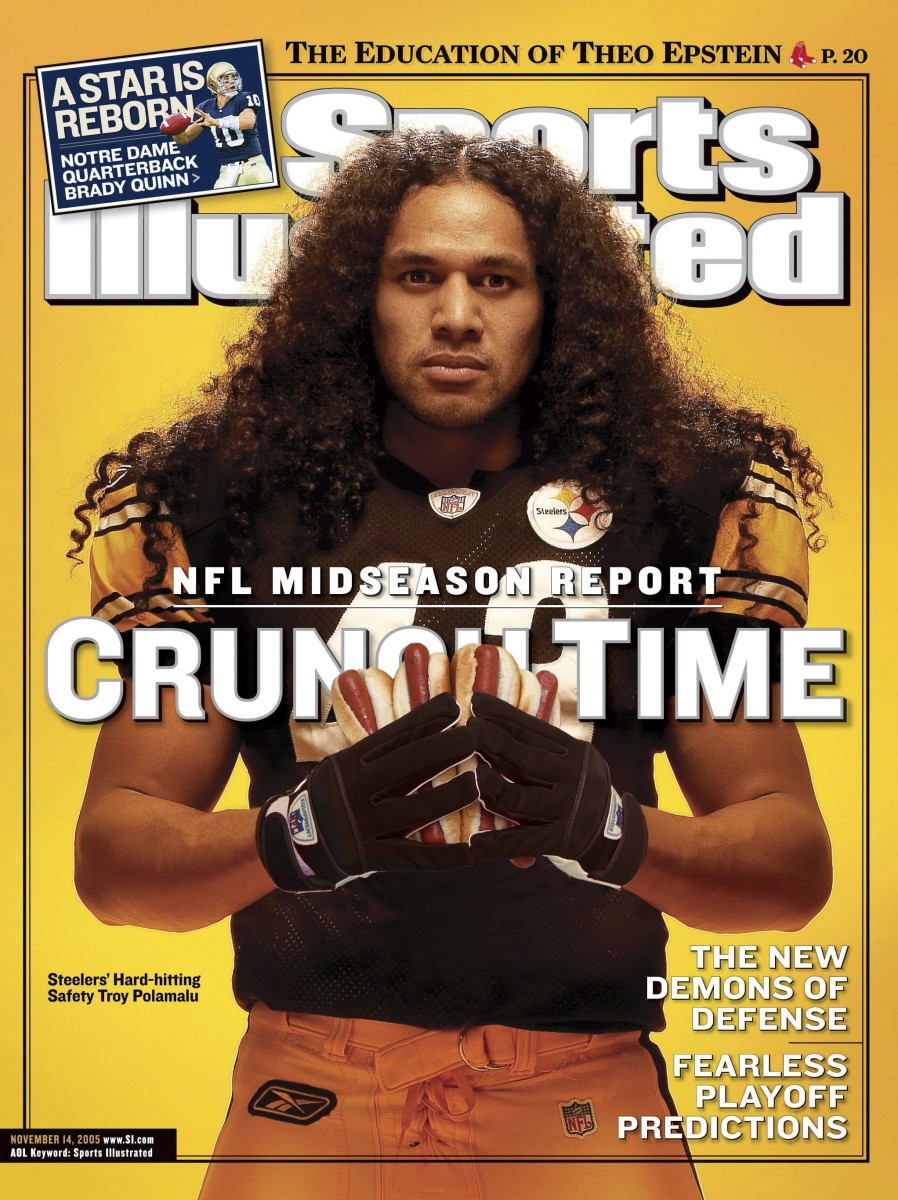
Originally from November, 2005.
John Thompson, President Reagan, Patrick Ewing
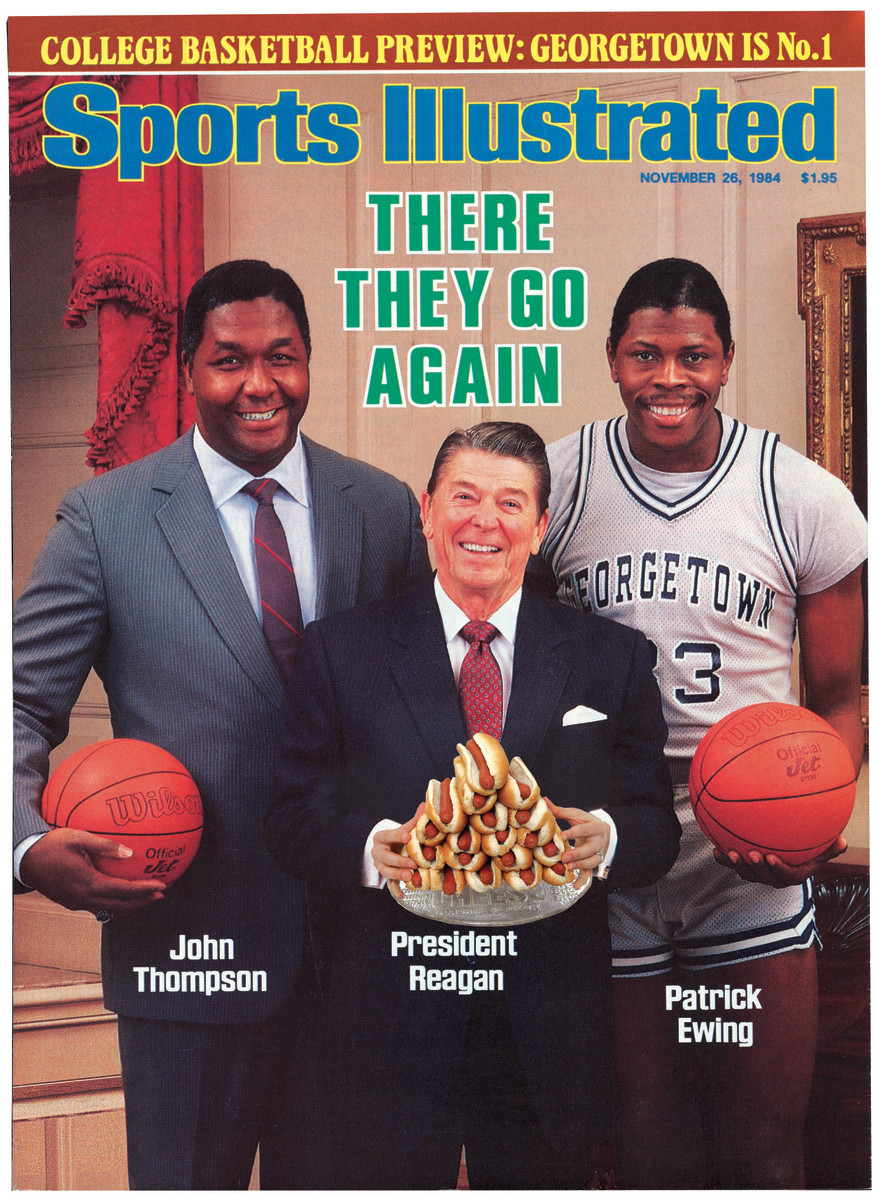
Originally from November 26, 1984
Y.A. Tittle
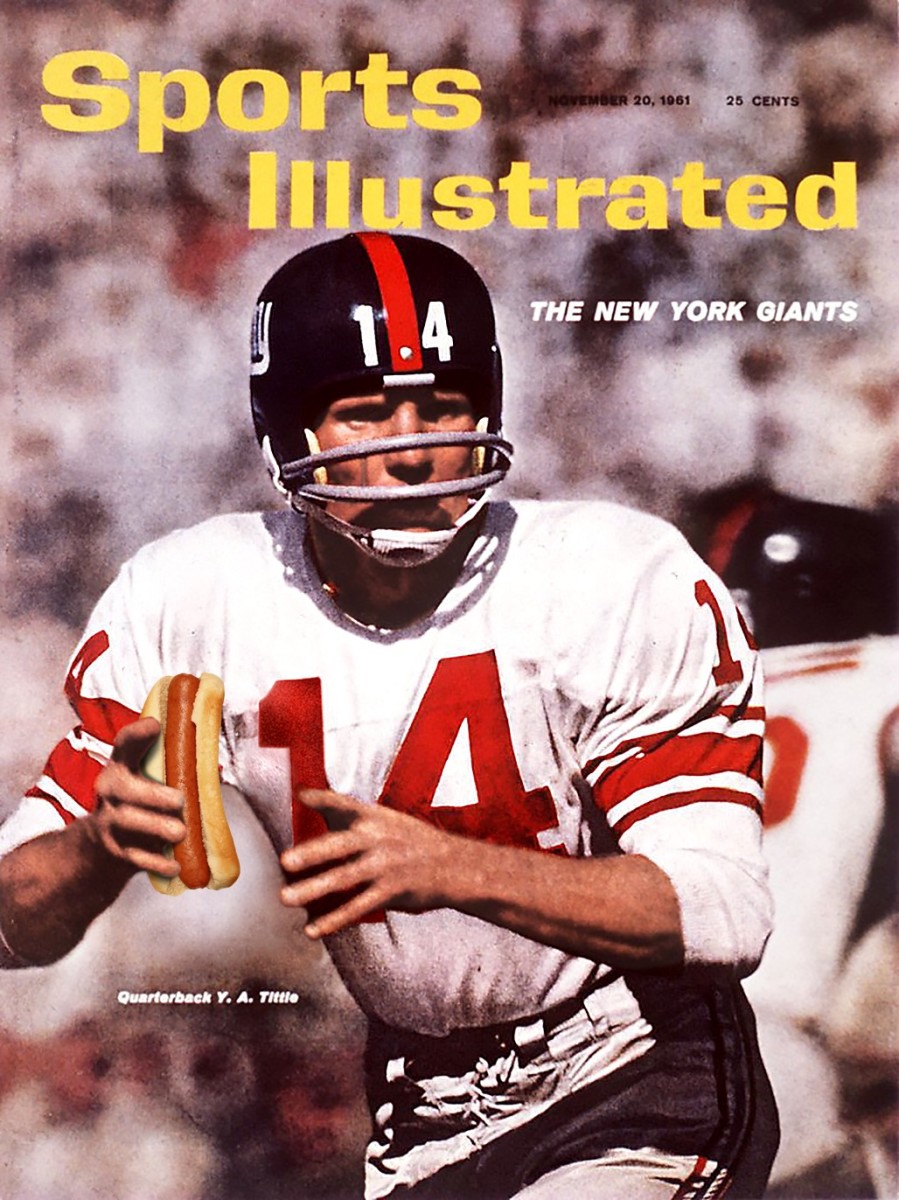
Originally from November, 1961
To nutritionists, Chestnut may seem less Ruth than Evel Knievel, a star-spangled daredevil defying the Reaper. Consumer advocate Ralph Nader once called hot dogs "among America's deadliest missiles." And even setting aside their nutritional value, Nader was onto something. Witness the rise of the hot dog cannon, firing frankfurters into crowds like edible ICBMs. When Clippers owner Steve Ballmer expressed interest in acquiring a hot dog cannon for games at the Staples Center, late-night host Conan O'Brien was horrified. "These are hot logs of meat being fired into the crowd," he gasped. "Aren't people going to be injured by them?"
And though O'Brien later warmed to the idea—and suggested Ballmer additionally spray Clippers fans with a "chili hose"—projectile wieners continue to cause chili con carnage. On Dollar Dog night at Citizens Bank Park, the Phillie Phanatic abruptly trained his hot dog gun on the suited mascot of the Hatfield Quality Meats company. The chef-hatted pig in bib overalls was struck in the head at point-frank range as a horrified TV announcer cried in aggrieved horror, "That's 98 miles per hour of compressed meat headed right at his noggin!"
"Throw in the Oscar Mayer Weinermobile, and you're at the five-way intersection of our national passions: litigation, firearms, binge eating, advertising and automobiles."
In 2009, Sluggerrr, the Royals' leonine mascot, behind-the-back-passed a hot dog toward a fan at Kauffman Stadium, and the foil-wrapped projectile struck 54-year-old John Coomer in the eye. Coomer sued, claiming medical expenses from a torn retina, and the case went all the way to the Missouri Supreme Court. And while the Royals were not held liable, America was forced to confront the consequences of its hot dog appetites, of hot dog lawsuits, hot dog firearms and holiday hot dog gluttony. Throw in the Oscar Mayer Weinermobile, and you're at the five-way intersection of our national passions: litigation, firearms, binge eating, advertising and automobiles. "They go together, in the good ol' U.S.A.: baseball, hot dogs, apple pie and Chevrolet," Ed Labunski sang throughout the 1970s in a series of impossibly catchy commercials that advertising mogul David Ogilvy called one of his favorite campaigns of all time.
A close second, however, may well be "I Wish I Were an Oscar Mayer Weiner," the jingle composed by Richard Trentlage in 1962. That song burrowed into Uncle Sam's inner ear, where it has remained ever since, placing the hot dog at the center of our national psyche. It is not too much to say, even, that the bunned meat is central to man's most mystifying metaphysical dilemma. The Zen seeker said to the hot dog vendor, "Make me one with everything." When the seeker asked for change, the vendor replied, "Change must come from within.”

The hot dog has long been a muse for American poets and novelists. As a teenager growing up on the southwest side of Chicago, in thrall to the White Sox, Shel Silverstein (author of The Giving Tree, A Light in the Attic and Where the Sidewalk Ends) became a Comiskey Park hot dog vendor, inspiring a bit of hot-doggerel that he called "Everything On It":
I asked for a hot dog
With everything on it
And that was my big mistake
'Cause it came with a parrot,
A bee in a bonnet,
A wristwatch, a wrench, and a rake....
Ignatius J. Reilly, protagonist of the Pulitzer Prize—winning novel A Confederacy of Dunces, sells hot dogs from a cart in the French Quarter of New Orleans, no doubt because the book's author, John Kennedy Toole, had himself been a vendor at Tulane Stadium. Dunces remains preeminent in the hot dog canon (which is distinct, as we have seen, from the hot dog cannon). "Nobody respects a hot dog vendor," Ignatius complains. "People look down on hot dog vendors." To which another character echoes: "Bums. They all bums."
They not all bums, though. Jackie Robinson vended dogs at the Rose Bowl and later played on that hallowed field for Pasadena Junior College, returning a kick 104 yards for a touchdown, still the stadium record. Like Silverstein, Eddie Einhorn was a Comiskey Park hot dog vendor in his youth, and he went on to become co-owner of the White Sox. When he oversaw the Charleston RiverDogs, Mike Veeck, son of former White Sox owner Bill Veeck, hired five mimes to reenact the game's plays in lieu of installing a video replay board, and those mimes were predictably pelted with a shower of hot dogs by the home fans. "Sold 26,000 hot dogs that night," Veeck later claimed, bringing joy and relative riches to his vendors.
"The vendor's box can be a genie's lamp. Rub it, with your latex-gloved hand, and all your wishes come true."
Some dog vendors become stars in their own right. Take Charlie Frank, whose name—like rural lawyer Sue Hicks—determined his occupation. Frank flogged dogs to generations of Phillies fans with his trademark cry of "Daaaaaag!" At White Sox games in Chicago, Ho Pun Padzett said nothing at all, simply tap-tap-tapping her vendor box with her serving tongs, or slap-slap-slapping the lid with her right hand. Tigers fans were serenaded by the opera-singing dog vendor Charley Marcuse ... until he was fired (allegedly having something to do with continuing conflicts with ketchup orderers). But the greatest of these sausage slingers was surely Ed Glynn, who grew up a mile and a half from Shea Stadium, where he sold dogs in the late 1960s. A decade later he was still working at Shea, but as a relief pitcher for the Mets, who commemorated his remarkable journey with a vendor's box bearing his uniform number 48.
Glynn, Robinson, Einhorn, Silverstein. The vendor's box can be a genie's lamp. Rub it, with your latex-gloved hand, and all your wishes come true.

According to legend, seldom-used Tigers slugger Gates Brown was preparing late in a 1968 game to eat two hot dogs in the dugout, as was his custom, when his manager, Mayo Smith (a man conspicuously named for a condiment), summoned him to pinch hit. Brown discreetly stuffed the franks down his uniform shirt and promptly doubled, requiring a head-first slide into second. "I had mustard and squashed meat all over me," Brown claimed. In another version of the story, the sauce was ketchup, and the umpire said, "Stay there, Gator. You're bleeding."
In Detroit, those hot dogs are Ball Park Franks, branded such by Michigan's Hygrade Food Products. In Los Angeles, Farmer John makes the Dodger Dogs. In Boston, Fenway Franks are by Kayem. When Queen Elizabeth II attended the first two innings of an Orioles home game in 1991, announcer Jon Miller was sad to see her leave, saying, "I was hoping she'd [stop by our booth] and read the Esskay Meats out-of-town scoreboard."
All of which is to say that we may be one nation, under dog, but we're highly divisible, our brand allegiances split down the side like the hot dog roll preferred by all right-thinking Americans ... or else sliced down the top, the way New Englanders like it. There are so many other American hot dog fault lines. Beef vs. pork. The aforementioned mustard vs. ketchup. (Or, if you're an adult, it seems: mustard vs. no mustard.) And the hot-button issue of our time, Is the hot dog a sandwich? (Spoiler: Of course not.)
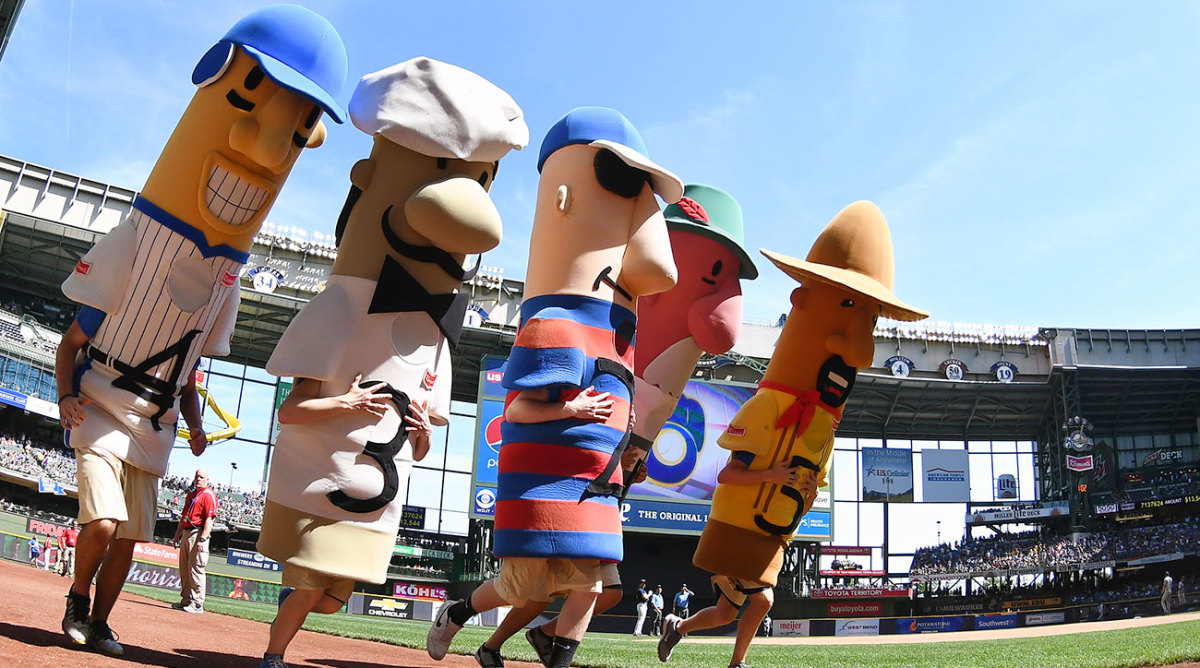
Our most contentious issue, though, is Whose dogs are the best? From his home in Tulsa, Tom Lohr has driven more than 57,000 miles in a 2008 Toyota RAV4, exclusively to answer that question. He blogs about his findings (Blog About a Dog) and has gathered them in a book (Gone to the Dogs). Lohr doesn't hesitate to say that the Brewers' Down Wisconsin Avenue Brat—18 inches long and drizzled in nacho cheese—is his favorite specialty dog. Forget Disneyland. Miller Park is, in his view, the Happiest Place on Earth. "Nobody," he says, "knows cased meat better than those guys."
It is Lohr's dream to one day suit up at Miller Park as one of the Klements Racing Sausages. "Ya gotta know somebody," he sighs about his fantasy of competing as the Hot Dog, the baseball-suited sausage in a field of foreign nationals (the lederhosened Bavarian Bratwurst, the chef-hatted Italian Sausage, the Polish Sausage in shades and the sombrero-wearing Chorizo). But of course these diverse sausages, emblematic of our national melting pot, are not just participants in a footrace. They're also engaged in a sophisticated arms race.

The arc of the sports universe is long, but it bends toward excess. The hot dog is no different, forever expanding like the cosmos, stretching from cocktail wiener to footlong to the 24-inch Boomstick that the Rangers sell for $26. Now every park has a novelty frank. In Kansas City the Sunrise Dog lies buried, like your dignity, beneath bacon, a fried egg, cheddar cheese and gravy. In Akron the Double-A RubberDucks dreamt up a hot dog that is concealed inside a bratwurst that is concealed inside a kielbasa, like Russian nesting dolls of arterial destruction. That one is called the Three Dog Night, presumably because the Triple Bypass raised liability issues. "It's like a turducken," sighs Lohr. "I ate most of it, but it must be a pound of meat. At least."
As novelty wieners go, he prefers the Diamondbacks' Churro Dog, a vague simulacrum of a sausage sandwich: one fried-dough churro, rolled in Oreo crumbs, topped by fro-yo, slathered in strawberry sauce, shot with whipped cream and still more Oreo crumbles. Alas, the Churro Dog is not for every palate. "I know hot dogs are bound up in the mythology of baseball, but ballparks are less fun to me than they once were," says Kraig, the hot dog historian. "They're full of loud music, and hot dogs have become jazzed up in just the same manner. We can go with the flow and say this is just the pop culture of our time, or we can lament it."
Joey Chestnut doesn't lament these pumped-up, pimped-out sausages. He has only ever wearied of one food eaten competitively: crab cakes left too long in the sun. (Sickened, he only ate 38, then abstained for a full year.) But hot dogs, for him, are a year-round indulgence. One of these Independence Days he believes he can eat 75 in 10 minutes, maybe even 80, but that's not really the point of his existence. Life's about the journey, not the indigestion. "I didn't grow up wanting to be a competitive eater," he says. "I had other things I wanted to do in life. But this thing got bigger and bigger, and I'm having a blast with it."
"I know I'm not building schools to educate children," Chestnut says. My job is goofy. But at least I make people smile."
Seven years ago, Chestnut quit his job as a construction engineer to lash his sail to a hot dog mast. "I know I'm not building schools to educate children," he says. "My job is goofy. But at least I make people smile. In construction I never made anyone happy. Now I have very few serious days. When I go places, kids with my Topps [baseball] card ask for my autograph."
To his way of thinking, the only thing that should get depressed at a ballpark is the big yellow button on the industrial mustard plunger, your palm smashing it like a contestant frantically buzzing in on Family Feud.
And so, on his Topps card Chestnut smiles above a mountain of bunned hot dogs, a baseball fan who stepped—hot dog in hand—through the looking glass. Get out of my dreams and onto my card. For lest we forget, hot dog is not just a modest noun and an immodest verb. It is also a joyous exclamation, as in Hallelujah! Hooray! Huzzah! Whee! Wahoo! Whoopee! Yahoo! And Yippie! Or, as Chestnut puts it, "I'm happy."
